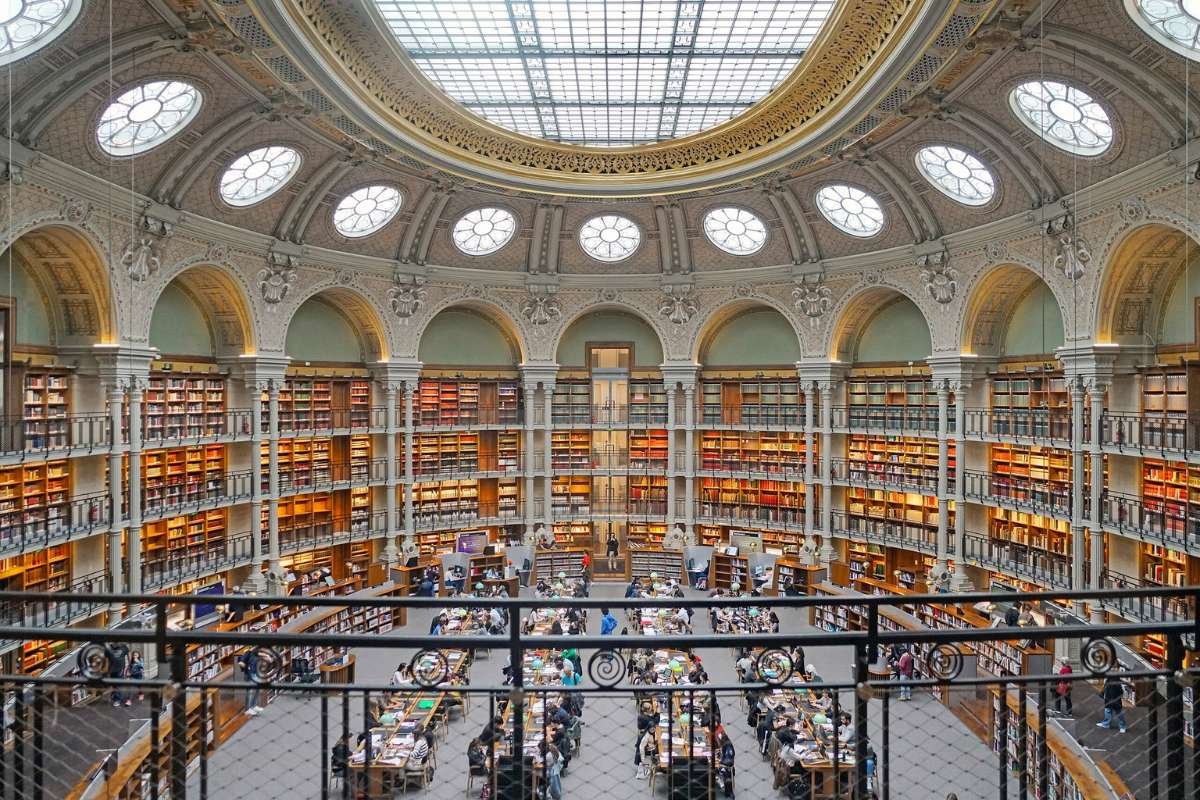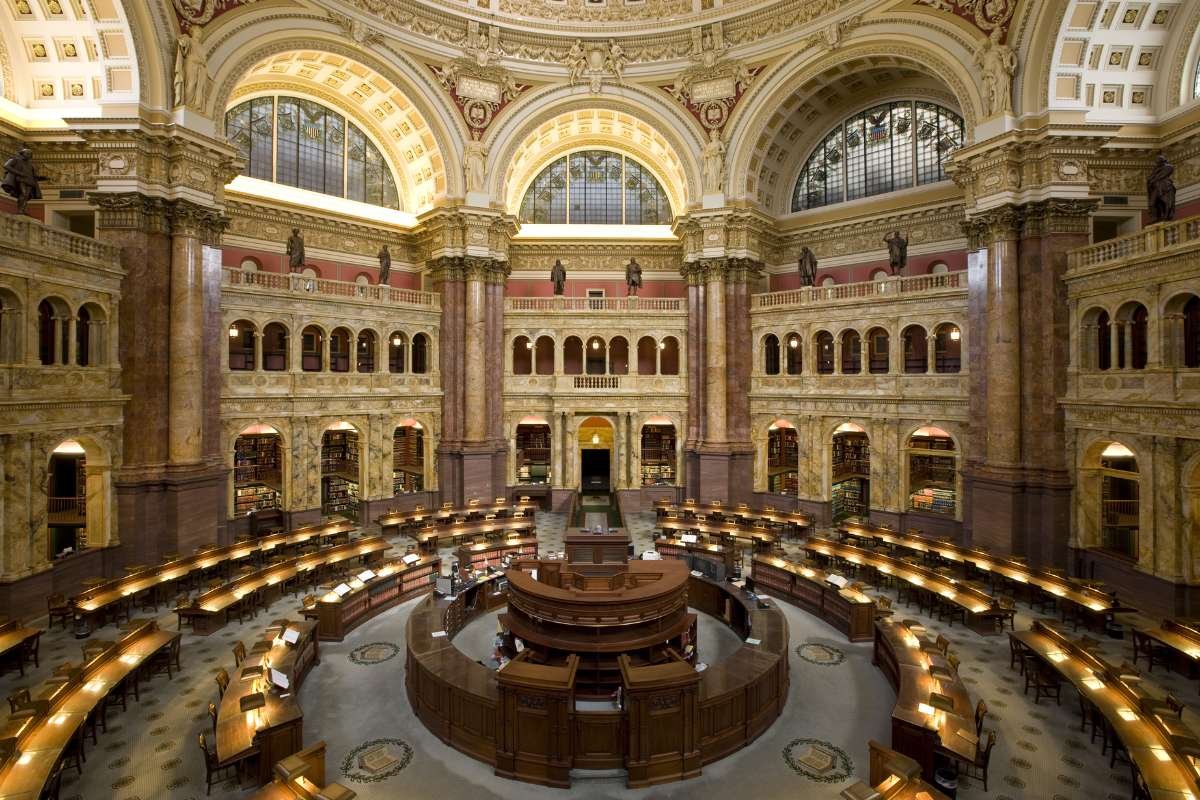Books have consistently been the foundation of human civilization. Given that libraries have always existed, among the myriad of ancient and newer libraries across the world, they have long been a repository of knowledge for scholars, researchers, and inquisitive minds. Among these extraordinary institutions stands the largest library in the world, serving as a light of understanding, with millions of volumes and resources. However, it is not the only library to do so; there are other libraries in the world that rival the largest library in size, history, and influence.
Let’s look at the 10 largest libraries in the world, what their collections consist of, and what makes them special.
Here is the Largest Library in the World That You Must Visit:
1. Library of Congress – Washington, D.C., USA
➤ Total Items: Over 173 million
The Library of Congress is officially recognized as the largest library in the world. Founded in 1800, it’s not just America’s national library but a global archive of culture and history. Its collection includes books, maps, manuscripts, photographs, recordings, and even rare films. Spread across three monumental buildings, it serves as both a research institution and a symbol of America’s commitment to preserving knowledge.
The Jefferson Building, with its stunning architecture and frescoes, is a masterpiece in itself. Scholars from around the world come here to explore the depths of human creativity and intellect.
2. British Library – London, United Kingdom
➤ Total Items: Over 170 million
The British Library stands proudly as Europe’s largest repository of knowledge. It houses treasures like the Magna Carta, Leonardo da Vinci’s notebooks, and original Beatles lyrics. With holdings in multiple languages, the British Library serves millions of visitors annually, both on-site and online. Its vast digital collection has made global access to literature easier than ever.
3. National Library of China – Beijing, China

➤ Total Items: Around 40 million
The National Library of China combines ancient wisdom and modern preservation. It contains extensive Chinese literature, historical archives, and rare ancient manuscripts. It also plays a vital role in digital preservation and the study of classical Chinese culture. The library’s architecture blends traditional Chinese aesthetics with futuristic design, symbolizing China’s balance between history and progress.
4. Russian State Library – Moscow, Russia
➤ Total Items: About 47 million
Known as the “Leninka,” the Russian State Library is a towering symbol of literary heritage. Established in 1862, it houses the world’s largest collection of Russian-language books and periodicals. Scholars regard it as an essential center for Slavic studies. The reading rooms here are vast and majestic, offering a glimpse into the grandeur of Soviet-era architecture.
5. National Diet Library – Tokyo, Japan
➤ Total Items: Over 44 million
Japan’s National Diet Library serves a role similar to that of the U.S. Library of Congress. It supports the Japanese legislature while preserving the nation’s intellectual output. From centuries-old Buddhist scriptures to modern government publications, it reflects Japan’s evolution through knowledge. Its advanced digitization initiatives make it one of the most accessible national libraries in Asia.
6. Bibliothèque nationale de France – Paris, France

➤ Total Items: Around 40 million
Founded in the 14th century, the Bibliothèque nationale de France (BnF) is a cornerstone of French cultural identity. It features manuscripts from medieval Europe, artworks, maps, and multimedia archives. Its Richelieu and François-Mitterrand sites blend old-world elegance with modern functionality. The BnF is also a hub for literary exhibitions and research in the arts and humanities.
7. National Library of Russia – St. Petersburg, Russia
➤ Total Items: Around 38 million
Founded by Empress Catherine the Great in 1795, the National Library of Russia preserves centuries of European and Russian literature. Its neoclassical design and vast manuscript collection make it one of the most beautiful and largest library in the world. It remains a center for historical research, offering unparalleled access to early Slavic texts and rare prints.
8. New York Public Library – New York City, USA
➤ Total Items: About 55 million
The New York Public Library (NYPL) is an iconic landmark of knowledge and architecture. Its main branch on Fifth Avenue — guarded by the marble lions “Patience” and “Fortitude” — symbolizes public access to education. The NYPL provides extensive archives, including rare historical newspapers, photographs, and one of the world’s largest research collections.
Its digital initiatives have helped millions access free e-books and research material worldwide.
9. National Library of Canada (Library and Archives Canada) – Ottawa, Canada

➤ Total Items: Over 54 million
The National Library of Canada, merged with the National Archives, stands as a vital institution for preserving the nation’s cultural memory. Its collections include books, government documents, artworks, and indigenous literature. With ongoing efforts in digitization and preservation, it ensures that Canada’s diverse heritage remains accessible to future generations.
10. Harvard University Library – Cambridge, USA
➤ Total Items: Around 21 million
As the oldest library system in the United States, the Harvard University Library represents academic excellence. Its vast network of over 70 branches supports research across disciplines — from law and medicine to arts and sciences. Beyond books, the library’s archives contain historical letters, maps, and scientific journals that fuel groundbreaking research worldwide.
Why Libraries Still Matter in the Digital Age?
While digital technology has transformed how we consume information, libraries remain irreplaceable. The largest library in the world isn’t just about scale — it’s about stewardship. These institutions curate, protect, and democratize knowledge, ensuring access for all.
From ancient scrolls to digital databases, libraries stand as bridges between past and future. They nurture critical thinking, inspire creativity, and support global literacy. In an age of misinformation, they are the ultimate guardians of truth.
Conclusion
The largest library in the world, the Library of Congress, is at the head of a worldwide network of institutions that protect the collective wisdom of humankind. The British Library’s historical manuscripts, China’s cultural treasures, and Harvard’s academic resources all demonstrate that knowledge is, indeed, without borders.
Going to any of these extraordinary libraries fundamentally transcends an academic experience; it is a pilgrimage to the core of human civilization. Whether in their stillness and silence or in their endless rows, one does not simply find books — one finds history, discovery, and the power of knowledge.









